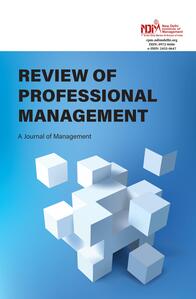
1 The Maharaja Sayajirao University of Baroda, Pratapgunj, Vadodara, Gujarat, India
Creative Commons Non Commercial CC BY-NC: This article is distributed under the terms of the Creative Commons Attribution-NonCommercial 4.0 License (http://www.creativecommons.org/licenses/by-nc/4.0/) which permits non-Commercial use, reproduction and distribution of the work without further permission provided the original work is attributed.
The implementation of e-Governance for various government schemes and projects is considered a positive movement for effective and transparent governance around the globe. India as an emerging economy is developing a strong governance network. According to figures from the Statista website, there are approximately 3,870 services of the government of India being included on the e-governance platform as on date 25 January 2022 and this is ever-increasing. The present study was done to evaluate the relationship between various selected criteria of e-governance services, namely benefits, integrity, accessibility, extensibility, problems faced and perceived usefulness with satisfaction of e-governance service users. The study was conducted among 100 users of e-governance applications/websites collected from Google Forms, by selected users of Vadodara city of State of Gujarat. The research study yielded major findings that hover around the dimension of integrity and perceived usefulness of e-governance schemes. It can be inferred that the e-governance schemes display the highest preferences of beneficiaries for integrity and perceived usefulness dimensions.
Accessibility, benefits, electronic governance, extensibility, government and governance
Introduction
Electronic Governance is the application of Information and Communication Technologies (ICTs) for delivering Government services through integration of various stand-alone systems between Government-to-Citizens (G2C), Government-to-Business (G2B), and Government-to-Government (G2G) services. It is often linked with back-office processes and interactions within the entire government framework. Through e-governance, the Government services are made available to the citizens in a convenient, efficient, and transparent manner. (IGI Global, n.d.)
e-Governance is considered a system through which the government department works and informs the citizens to disseminate the schemes/application-related details for their benefit, in turn automating the government process. The government harnesses information technologies such as internet, WAN, WWW and wide usage of mobile applications to enable e-governance users, and other deliverables of the government to enable transparency in their work. e-Governance enables efficiency, transparency and usefulness in working of various departments of the government, to offer their citizen-centric services (Bhatnagar & Singh, 2010).
There are researchers who have worked on the e-governance areas and the illustrative list of authors, namely Mufeed et al. (2013) have worked on e-governance delivery; Magele (2012) has worked on the introduction of new technology in the e-governance domains; and Pundhir and Sharma (2017) have worked on increasing the policy framework, governmental reforms and institutional framework in the country. Also, Hussain et al. (2022) have done extensive research on integrity of services from the information security. On the subject, many more authors have done extensive research, which is available in the references.
Considering the research gap, the research was conducted to comprehend and assess the effect of various schemes and related selected attributes related to the use of selected e-governance initiatives of the Government of Gujarat, namely ‘benefits, integrity, accessibility, extensibility, problems faced and perceived usefulness’ with satisfaction of users of e-governance services from Vadodara city of Gujarat. The researcher has showcased the relationship between the selected attributes and satisfaction of e-governance users through the Structural Equation Model (SEM) to visualise the detailed manifestation of the user/citizen’s behaviour towards the use of e-governance practices offered by the government.
Manifestations of e-Governance in India
Total online services of the Government of India from FY 2016–2021 are presented in Figure 1.
Figure 1. Total Online-services of the Government in India from FY 2016–2021.
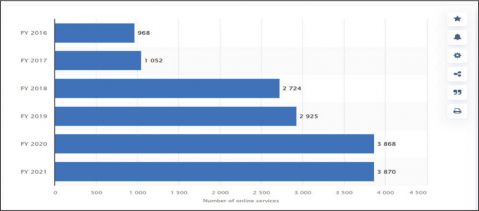
Source: www.Statista.com.
In the year 2006, when the government at Central Level launched its NeGP, few Departments/Ministries of Centre & State Governments had already initiated a few projects on e-governance platform. It is pertinent to pinpoint a few key e-governance schemes and applications conceived by the governments at both levels, evaluate their pros and cons and evaluate the conclusions and learnings from these schemes and applications. These few schemes and applications were taken up and categorised into three groups, namely ‘government to citizen (G2C) initiatives’, ‘government to business (G2B) initiatives’ and ‘government to government (G2G)’. The e-governance model presented in Figure 2 gives an overall idea about how e-governance service is integrated and reaches the community.
Figure 2. e-Governance Model.

Source: PwC report on Smart Governance & Technology, 2013, p. 17.
Review of Literature
The researcher has presented the review of literature in two parts, the first is a generic review of e-governance, and the second is on selected criteria-based review of the literature. The generic review of the literature is as follows.
Hamid et al. (2016) concluded relationships between the predictor’s variable and criterion variable to use e-governance in schools in Malaysia; here e-governance is considered a robust tool to curb corruption. The Indian government has a broader vision of converting all interactions between the citizens and the government to be in electronic mode by the year 2020 (Saini, 2016).
The article also mentions the different initiatives being taken in India and the associated challenges with them. Mukamurenzi et al. (2019) studied e-governance and problems faced in Rwanda on e-governance portal Irembo. According to Gohin (2015), the absence of knowledge and experience in developing available e-governance schemes/applications/websites in India echoes inadequate familiarity and knowledge about user interfaces (UI) and lack of strong understanding of e-governance scheme accessibility procedures within the e-Governance Project Team. This negatively impacts the accessibility of schemes/applications/websites in the Indian e-governance domain.
As per the United Nations e-Government Survey 2022, India has implemented the Digital India initiative with the sole aim of developing a people-centric ecosystem for the poor section of the society within the country. Further, the report mentions that the countries of Rwanda, Ecuador and India have a poorly developed telecommunications infrastructure network; in spite of the lack of network, the country has advanced its presence in the citizen-centric and inclusive online e-governance services (United Nations, 2022).
The Criteria-based Review of Literature
Mufeed et al. (2013) have focussed on the use of ICT in e-governance that supports improving the quality of governance and delivery mechanism. Magele (2012) has enumerated that the councils have to adapt to new technology overlooking the current basic local e-government, into more inclusive governance. The benefits of the e-governance in India, as per the author, has recommended that e-governance could be used for effective policy framework, enhancing governmental reforms and balancing the institutional framework of the country (Pundhir & Sharma, 2017). Hussain et al. (2022) have researched on the integrity of services being launched on the e-governance platform in the current scenario. The increase in cyber-attacks and citizens compromising their data and loss of money on payment gateways are a few of the research topics by the researcher. Rana (2013) has focussed on extending the e-governance services by putting emphasis on the management of various areas, namely information management, identity and access management, content management and standards management. Horst et al. (2007) have highlighted the perceived usefulness of digital services as the key for the government to offer e-government services. The risk, individual experience, and individual behaviour are significant attributes to identify the perceived usefulness of digitised services of the government.
Hamid et al. (2016) have explicitly considered the technology acceptance model, wherein the linkage between perceived usefulness and perceived ease of use were the key determinants for intention to use the e-governance services.
Shareef et al. (2011) have also studied the influence of models of Technological Adoption Model (TAM), Diffusion of Innovation Theory (DOI) and Theory of Planned Behaviour (TPB) on adoption of e-governance and found that these models are unable to capture the actual essence of the behavioural pattern of the user/citizens but would differ considering the different service maturity levels which are a result of organisational, technological, economical and social viewpoint (Abbas & Hamdy, 2015; Hamid et al., 2016). Belanche et al. (2012) have highlighted that the adoption of e-governance services depends on the trust and personal value orientation of the user/citizens of e-governance services offered. Rana and Dwivedi (2015) have experimented with and derived the Social Cognitive Theory (SCT) and considered attributes of anxiety, self-efficacy, social impact and deriving an online public grievance redressal system (OPGRS) in the Indian context.
The researcher has displayed various insights on variety of e-governance-related work being done in different domains and its perceived usefulness.
Research Gap
Earlier researchers in India and other countries had conducted research in the field of e-governance and have addressed several aspects, namely ‘A Survey of Acceptance of e-Government Services in the UK’ (Adeshara et al. (2004); ‘e-Governance Website Accessibility Evaluation by End User’s Perspective’ (Gohin, 2015); ‘The Effects of Perceived Usefulness and Perceived Ease of Use on Continuance Intention to Use e-Government’ (Hamid et al., 2016); ‘e-Government: Study of Factors Significantly Affects Adoption and Acceptance in State of Punjab’ (Kaur & Singh, 2015); ‘A Critical Study of Implication of e-Governance Services for Effective Communication with Special Reference to Citizens in Pune City’ (Kumbhar, 2012); ‘e-Governance Initiatives in India: A Review’ (Saini, 2016); Assessing the Impact of e-Government: A Study of Projects in India (Bhatnagar & Singh, 2010); ‘The Future of Digital Government. Department of Economic and Social Affairs, United Nations’ (United Nations, 2022) and ‘Benefits of e-Governance in India’ (Pundhir & Sharma, 2017).
There appears to be a practical-knowledge gap (Miles, 2017) in the prior research and a lack of rigorous research in the prior literature, some of these unexplored criteria and dimensions/variables of e-governance services appear to be lacking in the planning and implementation of e-governance app/websites offering services.
The researcher has found very few research studies, reports and articles in the research journals on selected attributes of e-governance and several unexplored dimensions that lately have engrossed research attention, namely benefits, integrity, accessibility, extensibility, problems faced and perceived usefulness.
To overcome the gap in existing literature related to e-governance, especially in the state of Gujarat, the researcher attempted to investigate the relationship between selected criteria of e-governance services and with the satisfaction of e-governance service users.
However, there are very few practical studies or action research in the field of evaluating the experience of users of e-governance services to offer meaningful suggestions for policy reforms as well as for improving the state of e-governance services functioning in various domains of e-governance service delivery in the Vadodara city of Gujarat state
Basic Terms of Research Study
There is an endeavour by researcher to explain various key terms. Wixom and Todd (2005) defined ‘accessibility as access to the information, expertise, and users with the ease within the user-generated content websites’. The term ‘Social Accessibility’ defined as: ‘having the ability to access social resources for the purpose of engaging’ (Di Gang, 2010). Kumar (2013) defined ‘extensibility as use of existing functionalities in new ways by the users’. Adeshara et al. (2004) defined ‘integration as using different types of sources to intermix the contents in order to reach more effectively to the other users of the network’. Kumbhar (2012) ‘A critical study of implication of e-governance services for effective communication with special reference to citizens in Pune city and various problems faced by e-governance users’.
Research Methodology
The main purpose of this study is to assess schemes and applications offered by the Government of Gujarat related to e-governance and its adaptation in Vadodara city of Gujarat state. This research study aimed to assess the opinion of the e-governance users about aspects of benefits, integrity, accessibility, extensibility, problems faced and perceived usefulness of the e-governance initiatives. The researchers used ‘exploratory and descriptive research design’ to study primary data that were collected through structured questionnaires with the help of Google Forms from total number of 100 e-governance service users in Vadodara city from Gujarat state. The collected primary data thereafter were examined using descriptive statistics, and hypotheses were tested using chi-square. The SEM was also developed to study and examine the relationship between variables under study.
Scope of Research Study
The scope of research study is restricted to measuring effect of selected criteria on satisfaction from e-governance initiatives, namely benefits, integrity, accessibility, extensibility, problems faced and perceived usefulness of e-governance services offered by the Local Municipal Corporation and Government of Gujarat to the users of Vadodara city. The results and findings of the research study are restricted to 100 respondents selected for collecting the primary data using google forms.
Primary Data Analysis
The analysis was done using descriptive statistics, for testing the hypotheses chi-square was used. The reliability and validity were measured for the research instrument.
Data Analysis and Interpretation
The researcher has conducted data analysis using descriptive statistics. The reliability and validity were also measured to validate the research instrument used for this research study.
Reliability and Validity of the Structured Non-disguised Questionnaire
The researcher tested the reliability and validity considering the content of the research instrument, using Cronbach’s Coefficient Alpha.
As per Table 1, the ‘Cronbach’s Alpha score’ (Cronbach, 1951) concluded that the result of test conducted for measuring of judgement of selected factors of e-governance initiatives eventually led to the perceived usefulness of e-governance users and the various values generated from the applications/websites had a wide range from 0.917 to 0.954 for Local Municipal Corporation e-governance initiatives and from 0.913 to 0.957 for Government of Gujarat e-governance initiatives that displayed ‘internal reliability of the scale’ and represents relationships among designated statements (Malhotra, 2007; Nunnally, 1981).
Table 1. Reliability of Opinion Towards e-Governance Services on Selected Criteria.
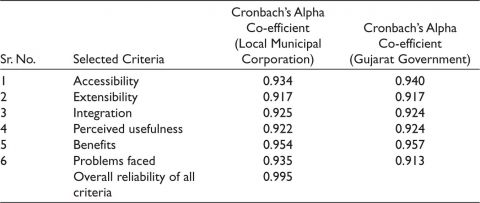
The study compared the mean values to arrive at a score that reflects validity of the content of the research instrument. The conclusion of the validity is displayed in Table 2. The result shows very less variance between the content of research instruments considering the different criteria and score of ‘average satisfaction’. Most of the users’ conclusions were found between ‘highly satisfied’ to ‘neutral’. Thus, different sets of questions fulfil the condition of validity.
Table 2. Comparison of Mean Scores of Experience/Satisfaction from e-Governance.

Respondents’ Profiles
The respondents’ profiles are presented in Table 3. Most of the respondents are in the age bracket of 31–45 years, with males forming a majority, with a maximum of them being graduates and with an annual income of `12 lacs and above.
Table 3. Profile of Selected Users of e-Governance Schemes/Applications/Websites.

As shown in Table 4, 76% of respondents are aware of the e-governance schemes offered by Municipal Corporation and 80% of respondents are aware of the e-governance schemes offered by Gujarat state.
Table 4. Overall Awareness of e-Governance Services in Gujarat State.

Awareness About E-governance Services Offered by Local Municipal Corporation
The awareness about e-governance services offered by Local Municipal Corporation of Vadodara city is shown in Table 5.
Table 5. Awareness of Local Municipal e-Governance Services in Vadodara City.
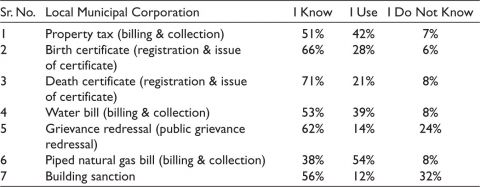
Table 5 reveals that the selected municipality e-governance services considered during the audit, conclude that a high percentage of respondents are aware of services and using the same too, however 24% of users have not heard about public grievance redressal and 32% of respondents are not aware of building sanction from town planning department being done online.
Awareness About e-Governance Services Offered by Government of Gujarat
The awareness among the e-governance users of Vadodara city about e-governance services offered by the Government of Gujarat is shown in Table 6.
As shown in Table 6, it can be inferred that the selected e-governance schemes and services offered by the Government of Gujarat signify that the awareness about the schemes is high, though the respondents may not have used the same. The scheme of e-Gram Vishwagram is still not popular among the rural population as 58% of respondents have responded about their ignorance about the scheme.
Table 6. Awareness of State Government e-Governance Services in Vadodara City.

Comparison of e-Governance Services Versus the Manual Services
Table 7 signifies the responses from respondents that, the number of visits to a government office has reduced with the introduction of e-governance platforms for the same services. The respondents have also responded that the cost of availing the service and time required for availing the service has come down with introduction of e-governance platforms.
Table 7. Response from e-Governance Users about Manual Services and e-Governance Services.

Table 8 depicts the responses from respondents, wherein the experience of using selected e-governance services has been taken vis-à-vis the behavioural intention and attitude of the user.
Table 8. Response of e-Governance Users about Behavioural Intention and Attitude.
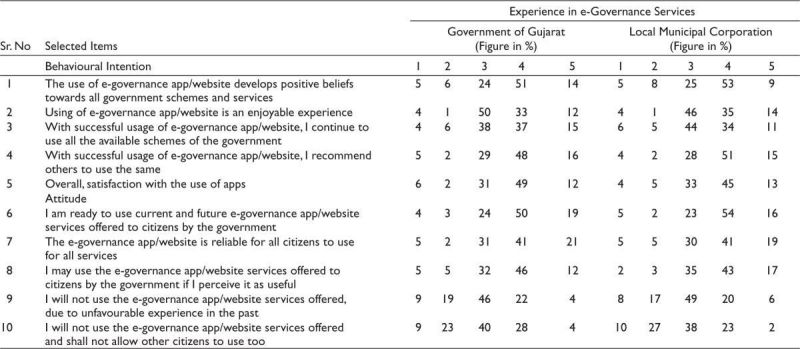
Experience of e-governance services for local municipal corporation and Government of Gujarat (Very Poor = 1, Poor = 2, Fair = 3, Good = 4 and Excellent = 5).
Findings and Implications of the Research Study
The researcher offered findings of implementation of various statistical tools and techniques that were put to use to conclude meaningful economic and social implications of this research study. The relationships of variables, namely ‘accessibility, extensibility, integration, perceived usefulness, benefits, problems faced’, with selected demographic variables are tested using the chi-square test.
The researcher attempted to present overall implications considering the results and evaluations of the primary data collected.
The Findings of the Chi-square Test Are as Follows
Hypothesis 1. There is no association between selected variables of e-governance services related to accessibility of e-governance services used by selected respondents of Vadodara city vis-à-vis selected e-governance service users’ selected background variables, namely ‘Age [A], Gender [G], Educational Qualifications [EQ] and Income [I]’.
The chi-square results as given in Table 9 revealed non-significant results for association between selected variables related to accessibility of e-governance services, except the criteria, namely ‘accessibility to a strong and robust application/website’; ‘e-governance applications/websites are accessible 24×7’; ‘easy to navigate website’; for Age group. Similarly, the criteria, namely ‘easy to navigate website’ is significant for the Gender and Income group. The criteria ‘e- governance apps/website is user friendly’ and other criteria, namely ‘instant answer to my actions (clicks)’, are significant for educational qualifications.
Table 9. Selected e-Governance Users’ Opinion on Selected Variables of Accessibility vis-à-vis Selected Background Variables of e-Governance Service of Vadodara City.

Note: The bold numbers are significant values depicted.
Hypothesis 2. There is no association between selected variables of e-governance services related to extensibility of e-governance services used by selected respondents of Vadodara city vis-à-vis selected e-governance service users selected ‘background variables, namely Age [A], Gender [G], Educational Qualifications [EQ] and Income [I]’.
Considering Table 10, the chi-square results show non-significant results for association between selected variables related to extensibility of e-governance services, except the criteria, namely ‘e-governance app/website provides detailed information about the service offered’, for the Age group. Similarly, the criteria, namely ‘e-governance app/website administrator/backend technical team are quick to resolve the issues’ is significant for the Income group. The criteria ‘e- governance app/website provides detailed information and description of the e-governance service offered’ and other criteria, namely ‘the information provided by website is easy to comprehend’, are significant for the Income group.
Table 10. Selected e-Governance Users’ Opinion on Selected Variables of Extensibility vis-à-vis Selected Background Variables of e-Governance Service of Vadodara City.
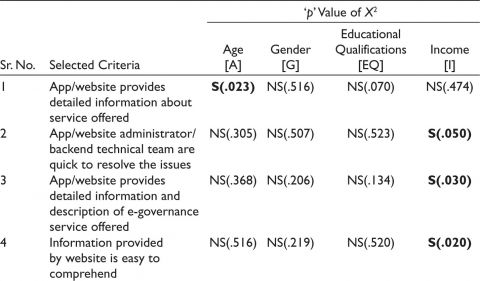

Note: The bold numbers are significant values depicted.
Hypothesis 3. There is no association between selected variables of e-governance services related to Integration of e-governance services used by selected respondents of Vadodara city vis-à-vis selected e-governance service users selected ‘background variables, namely Age [A], Gender [G], Educational Qualifications [EQ] and Income [I]’.
The results of chi-square displayed in Table 11 show non-significant results for association between selected variables related to Integration of e-governance services, except the criteria, namely ‘app/websites integrates different services offered for a particular service on one dashboard’, for Age and Gender group. Similarly, the criteria, namely ‘app/website integrates different sub-processes of a service, making it a convenient hassle-free user-interface’ is significant for age, Gender and Income group. The criteria ‘app/website displays simplified payment gateways’ is significant for Age and Income groups. The criteria, namely ‘website offers various payment options’, is significant for the age group.
Table 11. Selected e-Governance Users’ Opinion on Selected Variables of Integration vis-à-vis Selected Background Variables of e-Governance Service of Vadodara City.

Note: The bold numbers are significant values depicted.
Hypothesis 4. There is no association between selected variables of e-governance services related to ‘Perceived Usefulness’ for e-governance schemes used by selected users of Vadodara city vis-à-vis selected e-governance service users’ selected ‘background variables, namely Age [A], Gender [G], Educational Qualifications [EQ] and Income [I]’.
The results of chi-square test given in Table 12 results show the non-significant results for association between selected variables related to the Perceived Usefulness of e-governance services, except the criteria, namely ‘using e-governance app/web saves time for avail services’, for Gender and Income group. Similarly, the criteria, namely ‘using e-governance app/web results in charging affordable fees for availing respective services of government by citizens’ is significant for Age and Gender group. The criteria ‘using e-governance app/web provides flexibility to citizens in using services as per convenience’ is significant for age and educational qualification group. The criteria, namely ‘notification of description of the failure of e-governance services, is shared by website’, is significant for Age and Income group.
Table 12. Selected e-Governance Users’ Opinion on Selected Variables of Perceived Usefulness vis-à-vis Selected Background Variables of e-Governance Service of Vadodara City.

Note: The bold numbers are significant values depicted.
Hypothesis 5. There is no association between selected variables of e-governance schemes related to the Advantages of using e-governance schemes by selected respondents of Vadodara city vis-à-vis selected e-governance service users selected ‘background variables, namely Age [A], Gender [G], Educational Qualifications [EQ] and Income [I]’.
Table 13 showcases the result of the chi-square test showing non-significant results for association between selected variables related to benefits of e-governance services, except the criteria’s, namely ‘services offered by app/web are transparent to use’; ‘services offered by app/web hassle free to use by citizens’ and ‘app/web are economical/affordable to citizens for its usage’ for Age and Gender group. Similarly, the criteria, namely ‘app/web usage saves time’ and ‘app/web are simple to use’ is significant for educational qualification and age group respectively. The criteria ‘app/web facilitates in auto record generation for reference of citizens’ and ‘app/web offers personalised services to citizens’ are significant for educational qualification and age group respectively.
Table 13. Selected e-Governance users’ Opinions on Selected Variables of Benefits vis-à-vis Selected Background Variables of e-Governance Service of Vadodara City.
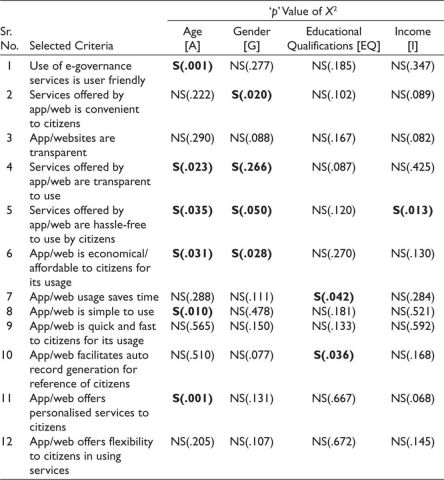
Note: The bold numbers are significant values depicted.
Hypothesis 6. There is no association between selected variables of e-governance services related to Problems Faced by e-governance services used by selected respondents of Vadodara city vis-à-vis selected e-governance service users selected ‘background variables, namely Age [A], Gender [G], Educational Qualifications [EQ] and Income [I]’.
The chi-square results shown in Table 14 portray non-significant results for the association between selected variables related to Benefits of e-governance services, except the criteria, namely ‘app/web has reduced cost of obtaining various civic and other services’ for Educational Qualifications group. The criteria, namely ‘lack of monitoring of quality & efficiency of outsourced agencies by government bodies, for different e-governance services employed’ is significant for Age and Income group. The criteria ‘fear of confidentiality in providing personal/business data, for e-governance services’ is significant for the Gender group. The criteria ‘Outsourced team employees are an untrained work force’; ‘government employees are an untrained work force’; ‘e- governance websites server hangs frequently during usage’ and ‘Process of usage of e-governance services is complex’ are significant for Age group.
Table 14. Selected e-Governance Users’ Opinion on Selected Variables of Problems Faced vis-à-vis Selected Background Variables of e-Governance Service of Vadodara City.
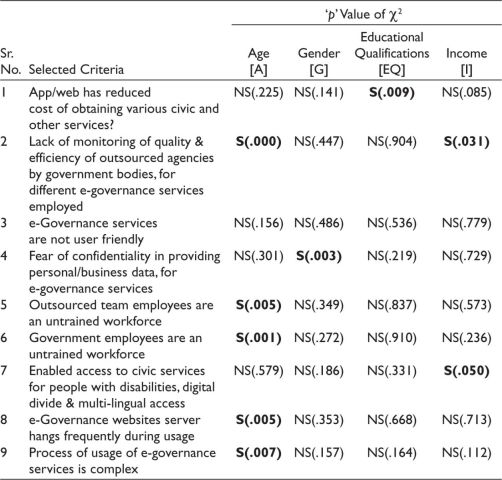
Note: The bold numbers are significant values depicted.
Structural Equation Model
Figure 3 represents ‘Simple Regression Model’ which demonstrates the relationship between the observed variable, namely ‘overall satisfaction’ with selected criteria of e-governance. The variables other than selected 06 variables assume the error value as ‘01’, that predicts the relationship between overall satisfaction and selected criteria of e-governance.
Figure 3. Structured Equation Model [SEM] Model Showing Relationship Between Selected Attributes of e-Governance and Overall Satisfaction of Users of e-Governance Services.
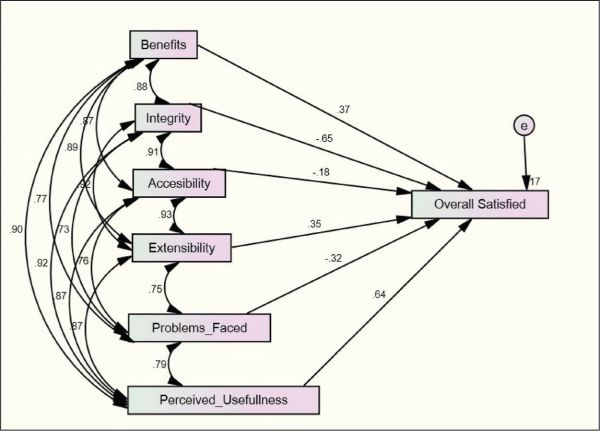
The value shown against the two-side arrow reflects dual relationships between variables (0.87, 0.92, 0.76, 0.73, 0.90, 0.77, 0.89 and 0.88) indicates the correlation between them. The values shown against single side arrow, depict direct relationship (0.65, 0.64, 0.37, 0.35, 0.32 and 0.18) are ‘standardised regression weights’. It meant that the ‘overall satisfaction’ with e-governance schemes/applications was found as mainly influenced by integrity (0.65), perceived usefulness (0.64), benefits (0.37), extensibility (0.35), problems faced (0.32) and accessibility (0.18).
Key Findings of the Research Study
The usage of mobile data and Wi-Fi, as well as awareness about various e-governance initiatives, have been found very high; the users access various e-governance schemes through mobile and Wi-Fi multiple times a day.
The respondents have validated their knowledge about Local Municipal Corporation schemes such as property tax billing and collection, birth and death certificate registration and issue, water bill payment, and PNG installation and billing. The knowledge and usage of local municipal corporation schemes such as public grievance redressal and building sanction are relatively low.
The Government of Gujarat’s e-governance schemes such as RTO issue and renewal, land registration e-Dhara and 108 EMRI are very popular among the respondents, however, the knowledge and awareness about e-governance schemes such as e-City, Tele-Fariyad, CCTNS, iPDS, GHMIS, MA and e-Gram Vishwagram are either low or average.
Large number of respondents still believe in physically visiting the government office to avail the scheme, rather than using the scheme on the internet. The analysis shows that the physical visits to government offices have reduced with government schemes getting integrated with e-governance platforms. Also, physical visits to government offices incur high costs; by accessing e-governance schemes, users are able to reduce the overall cost. The time required to physically visit the government offices to access schemes is high.
For accessing e-governance schemes of Local Municipal Corporation, accessing e-governance schemes online develops positive belief among users instilling confidence in them for the schemes, users have had a fairly good experience in accessing the schemes online. The reach of government schemes has fairly increased among users, as a greater number of users are using the schemes.
For accessing e-governance schemes of the Government of Gujarat, certain of the e-governance portals are easy to access and manoeuvre but certain ones are difficult to access. Uploading and downloading documents are an issue at certain times. The integration with payment gateway is an issue at certain times. Most of the portals have navigation issues related to slow servers at the backend.
For extensibility, e-governance scheme users of Local Municipal Corporation, the schemes could be more detailed on the portals, the issues do take a very time to be responded to by the administrator of the website. The schemes on the website are surely explained in detail but a better and easy explanation could help.
For extensibility, e-governance scheme users of the Government of Gujarat, certain schemes are explained well, but certain schemes are not explained well on the portal, it is not easy to comprehend and understand. The web administrator of the scheme is unable to resolve the backend issues.
For integration-related findings of e-governance schemes of Local Municipal Corporations, most of the schemes can be seen on one portal, with ease to access the schemes and payment gateways integrate if there is a payment requirement.
For integration-related findings of e-governance schemes of Government of Gujarat, the schemes and applications are available on different sites and portals, certain ones from same department may be on one portal. The portals have a convenient payment gateway too, at times these sites do have a delay in accessing various pages on mouse clicks, as the backend servers hosting the sites may be slow.
For assessing the usefulness of the e-governance schemes at the Local Municipal Corporation, the respondents responded by mentioning that e-governance platforms have reduced the cost-of-service utilisation, with immense saving of time, giving transparency of service, responsibility and accountability of government departments.
For evaluating the ‘benefits of e-governance schemes of Local Municipal Corporation’, respondents have responded that the schemes are user-friendly and convenient to use, though there are hassles to understand the details of the scheme and usage of the portal, surely there is a saving of time, offer flexibility of usage and time of usage.
For evaluating the ‘benefits of e-governance schemes of Gujarat government’, the respondents have responded by mentioning that schemes are not user-friendly, the details of schemes are not understood well in most of the schemes, though they offer transparency post application. Not all the portals of the schemes are hassle-free, but they offer flexibility in time and use.
For problems evaluation of e-governance schemes of Local Municipal Corporation, the respondents have responded by mentioning that the cost of obtaining service has reduced, the users also agree that the quality of service offered by outsourced employees is not acceptable, also the government employees have a very shallow understanding of the e-governance portal, resulting into wastage of precious time of users. The servers which host the portals are also not equipped to take the requisite website load.
For problems evaluation of e-governance schemes of the Government of Gujarat, the respondents have responded by mentioning that the cost of obtaining the service has surely reduced but there is, at times, an issue with people from outsourced agencies and government officials unaware of the way the site works and benefits that can be acquired from the website. Certain schemes of the Government of Gujarat are not user-friendly, with complex processes.
For assessing the attitude of e-governance users in Local Municipal Corporation and Government of Gujarat, the respondents have responded by mentioning that they will use the websites of various e-governance schemes, as it is helpful.
For assessing the perceived importance of e-governance users in Local Municipal Corporation and Government of Gujarat, large percentage of respondents have responded by mentioning that though there are benefits of using e-governance applications on a positive note, there are certain respondents who are negative for specific schemes/websites.
For assessing the overall satisfaction of e-governance users in Local Municipal Corporation and Government of Gujarat, the respondents have responded by mentioning that they are satisfied with using the e-governance websites.
Significance of the Research Study
The findings of the research work are expected to be useful for e-governance users and governmental departments, as it will be identifying the impact of features of various schemes/applications on the perception of perceived usefulness impacting the behaviour intention and attitude, of the users. It would greatly impact for better understanding and utilisation of e-governance applications/websites. The research study would be expected to be utilised by various e-governance application/website developers for the design of varied strategies beneficial in growing the utilisation of various e-governance initiatives of the government.
Discussion and Implication of the Research Study
The researcher made an attempt to conduct a study from 100 respondents from Vadodara city and the implications of the study are as follows.
The study supports the evidence that people use the internet, looking into the IT boom, which is further expected to rise in the times to come and hence the usage of the internet is increasing day by day. Hence it can be inferred that the reach and success of e-governance programmes from the government could have a wider reach among users in the society. The awareness about e-governance being high, adaptation of various applications and initiatives could be successful.
There is evidence from the research study that the knowledge and utilisation of the e-governance initiative by users give confidence to introduce more initiatives on the e-governance platform by various departments of the government. Since the reach of e-governance is vast, other applications and e-governance initiatives could be introduced too.
The study has further highlighted that use of e-governance services such as e-Gram Vishwagram, iPDS, Mukhyamantri Amrutam and CM’s Tele-Fariyad (1505) is poor in rural populations. Hence the study necessitates strengthening the e-governance schemes in the rural belt of Gujarat state as lot of rural schemes are offered by the government, which require a wider reach.
The study implies the favour of respondents, by endorsing that the overall cost of, accessing e-governance schemes goes down on e-governance websites, also convenience of time and place is flexible in using the e-governance schemes, giving added transparency and financial security in using the schemes.
The finding of the study insists on an urge to focus more on making the websites more user-friendly, with an easy language and easy manoeuvrability on the UI, so that e-governance user of each Age group, Gender, with varied Educational Qualifications, and vide Income group can access the same.
Recommendations
The key recommendations based on the research study are as follows:
Declaration of Conflicting Interests
The authors declared no potential conflicts of interest with respect to the research, authorship and/or publication of this article.
Funding
The authors received no financial support for the research, authorship and/or publication of this article.
Abbas, H. A., & Hamdy, H. I. (2015). Determinants of continuance intention factor in Kuwait communication market: Case study of Zain-Kuwait. Computers in Human Behavior, 49, 648?657. https://doi.org/10.1016/j.chb.2015.03.035
Adeshara, P., Juric, R., Kuljis, J., & Paul, R. (2004). A survey of acceptance of e-government services in the UK. Journal of Computing and Information Technology, 12(1), 415?420. https://doi.org/10.1109/ITI.2004.242073
Belanche, D., Casaló, L. V., & Flavián, C. (2012). Integrating trust and personal values into the Technology Acceptance Model: The case of e-government services adoption. Cuadernos de Economía y Dirección de la Empresa, 15(4), 192?204. https://doi.org/10.1016/j.cede.2012.04.004
Bhatnagar, S. C., & Singh, N. (2010). Assessing the impact of e-government: A study of projects in India. https://itidjournal.org/index.php/itid/article/download/523/523-1394-2-PB.pdf
Cronbach, L. J. (1951). Coefficient alpha and the internal structure of tests. Psychometrika, 16(3), 297?334. https://doi.org/10.1007/BF02310555
Di Gang, P. M. (2010). The co-creation of value: Exploring engagement behaviourism user-generated content Websites. Florida State University.
Gohin, V. (2015). E-governance website accessibility evaluation by end user?s perspective. International Journal of Applied Environmental Sciences, 10(1). https://www.ripublication.com/ijaesspl/ijaesv10n1spl_02.pdf
Hamid, A. A., Razak, F. Z. A., Bakar, A. A., & Abdullah, W. S. W. (2016). The effects of perceived usefulness and perceived ease of use on continuance intention to use e-government. Procedia Economics and Finance, 35, 644?649. https://doi.org/10.1016/S2212-5671(16)00079-4
Horst, M., Kuttschreuter, M., & Gutteling, J. M. (2007). Perceived usefulness, personal experiences, risk perception and trust as determinants of adoption of e-government services in the Netherlands. Computers in Human Behavior, 23(4), 1838?1852. https://doi.org/10.1016/j.chb.2005.11.003
Hussain, M., Talpur, M. S. H., & Humayun, M. (2022). The consequences of integrity attacks on E-governance: Privacy and security violation. In Cybersecurity measures for E-government frameworks (pp. 141?156). IGI Global. https://doi.org/10.4018/978-1-7998-9624-1.ch009
IGI Global. (n.d.). What is e-governance. https://www.igi-global.com/dictionary/cyber-capability-framework/8702
Kaur, M., & Singh, A. (2015). E-government: Study of factors significantly affects adoption and acceptance in state of Punjab. http://ijcsit.com/docs/Volume%206/vol6issue05/ijcsit2015060582.pdfKumar, S. P. (2011). E-governance and decentralised planning in Kerala. http://hdl.handle.net/10603/8482
Kumar, S. P. (2013). E-governance and decentralised planning in Kerala [Doctoral dissertation, University of Kerala].
Kumbhar, M. A. (2012). A critical study of implication of e-governance services for effective communication with special reference to citizens in Pune city. http://hdl.handle.net/10603/5433
Magele, C. (2012). How to move from local e-government to collaborative e-governance; Guardian News and Media Limited. http://www.theguardian.com/local-government network/2012/may/08/local-government-e-citizenship
Malhotra, N. K. (2007). Marketing research an applied orientation (5th ed., p. 315). Pearson Prentice Hall.
Miles, D. A. (2017). A taxonomy of research gaps: Identifying and defining the seven research gaps, doctoral student workshop: Finding research gaps?Research methods and strategies, Dallas, Texas. https://www.academia.edu/35505149/ARTICLE_RESEARCH
Mufeed, S. A., Charag, O., & Mufeed, U. (2013). Impact of e-governance system practices on organizational innovation and achievement of sustainable development goals in India [Paper presentation]. International conference on sustainable development and Technological innovation. Islamic University.
Mukamurenzi, S., Grönlund, Å., & Islam, M. S. (2019). Challenges in implementing citizen-centric e-government services in Rwanda. Electronic Government, an International Journal, 15(3), 283?302. https://doi.org/10.1504/EG.2019.100519
Nunnally, J. C. (1981). Psychometric theory (pp. 15?25). Tata McGraw-Hill Publishing Ltd.
Pundhir, S., & Sharma, D. (2017). Benefits of e-governance in India. International Journal of Science Technology and Management, 6(2), 751?755.
Rana, A. (2013). Scope and deployment strategies of e-governance in India: A survey. International Journal of Interactive Computer Communication, 3(1), 1?10. https://www.researchgate.net/publication/311543720_SCOPE_AND_DEPLOYMENT_STRATEGIES_OF_E-GOVERNANCE_IN_INDIA_A_SURVEY
Rana, N. P., & Dwivedi, Y. K. (2015). Citizen?s adoption of an e-government system: Validating extended social cognitive theory (SCT). Government Information Quarterly, 32(2), 172?181. https://doi.org/10.1016/j.giq.2015.02.002
Saini, P. (2016). E-governance initiatives in India: A review. https://www.academia.edu/25049451/E_Governance_Initiatives_in_India_A_Review
Shareef, M. A., Kumar, V., Kumar, U., & Dwivedi, Y. K. (2011). E-government Adoption Model (GAM): Differing service maturity levels. Government Information Quarterly, 28(1), 17?35. https://doi.org/10.1016/j.giq.2010.05.006
Statista Research Department. (2022). Number of online services provided by the government in India from financial year 2016 to 2021. https://www.statista.com/statistics/1170639/india-number-of-online-services-provided-by-the-government/
United Nations. (2022). E-government survey 2022: The future of digital government. https://desapublications.un.org/sites/default/files/publications/2022-09/Web%20version%20E-Government%202022.pdf
Wixom, B. H., & Todd, P. A. (2005). A theoretical integration of user satisfaction and technology acceptance. Information Systems Research, 16(1), 85?102. https://doi.org/10.1287/isre.1050.0042